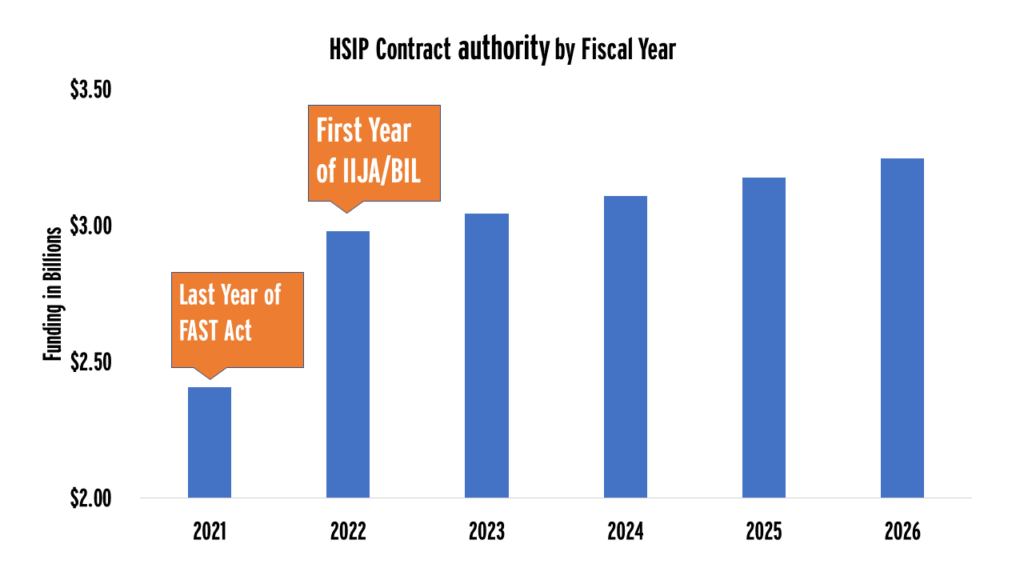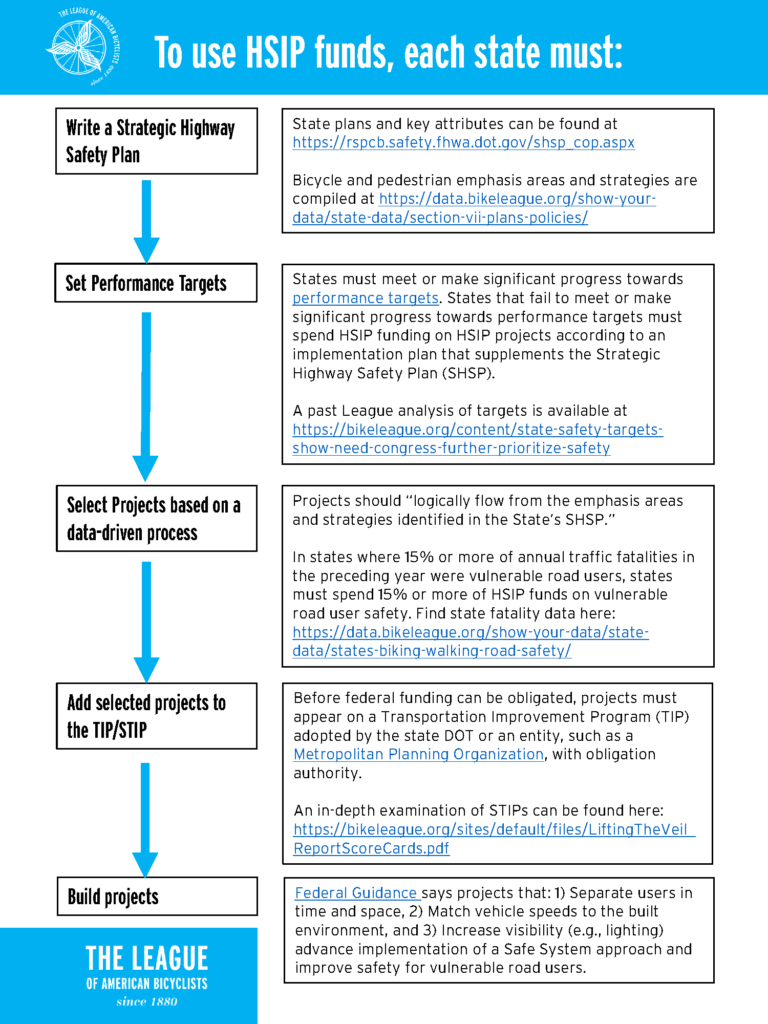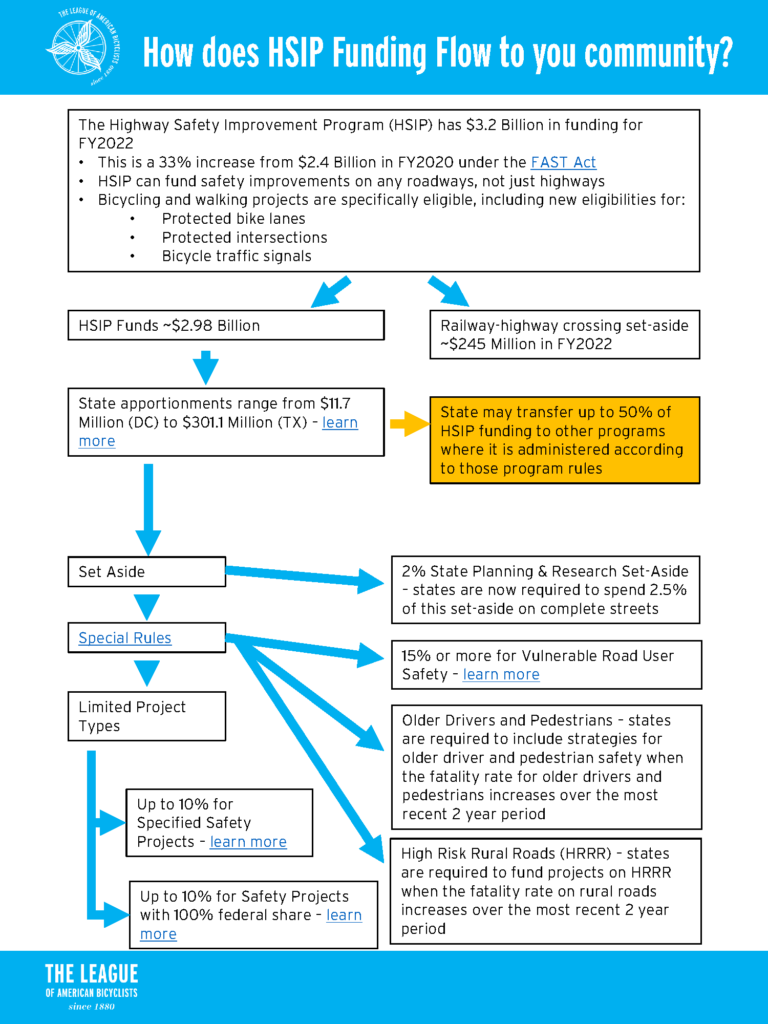What’s new? Why HSIP?
The Highway Safety Improvement Program (HSIP) provides roughly $3 Billion each year for safety projects throughout the United States. Under the Infrastructure Investment and Jobs Act (IIJA), also known as the Bipartisan Infrastructure Law (BIL), there are three reasons that people interested in improving bicycling and walking should discuss HSIP with their local elected officials and agency staff.
New Emphasis on Biking and Walking
Vulnerable Road User Special Rule
Under the IIJA/BIL every state is now subject to a Vulnerable Road User (VRU) Special Rule created by Congress. The VRU Special Rule requires that states where vulnerable road users make up 15% or more of traffic fatalities spend 15% or more of HSIP funds on projects to improve VRU safety.
The VRU Special Rule only considers non-motorized fatalities, which, by reference to 23 CFR 490.205, refers to fatalities with the FARS person attribute codes for Pedestrian, Bicyclist; Other Cyclist, and Person on Personal Conveyance.
Vulnerable Road User Safety Assessment
By November 2023 each state must complete a Vulnerable Road User (VRU) Safety Assessment. Under the Infrastructure Investment and Jobs Act/Bipartisan Infrastructure Law, the VRU Safety Assessment shall include:
- A quantitative analysis of vulnerable road user fatalities and serious injuries that—
- includes data such as location, roadway functional classification, design speed, speed limit, and time of day;
- considers the demographics of the locations of fatalities and serious injuries, including race, ethnicity, income, and age; and
- based on the data, identifies areas as ‘high risk’ to vulnerable road users; and
- a program of projects or strategies to reduce safety risks to vulnerable road users in areas identified as high risk.
- REQUIREMENT FOR TRANSPORTATION SYSTEM ACCESS.— The program of projects developed to reduce safety risks to vulnerable road users in areas identified as high risk may not degrade transportation system access for vulnerable road users.
In carrying out a vulnerable road user safety assessment under paragraph (1), a State shall use data from the most recent 5-year period for which data is available.
In carrying out a vulnerable road user safety assessment under paragraph (1), a State shall—
- take into consideration a safe system approach; and
- consult with local governments, metropolitan planning organizations, and regional transportation planning organizations that represent a high-risk area.
A State shall update the vulnerable road user safety assessment of the State in accordance with the updates required to the State strategic highway safety plan.
New Biking and Walking Projects
Under the IIJA/BIL several new types of bicycle and pedestrian infrastructure are explicitly eligible for HSIP funding. The Federal Highway Administration has also updated its "Proven Safety Countermeasures" to recognize new project types for bicycle and pedestrian safety.
New Project Types under BIL/IIJA
- Protected bike lanes
- Protected intersections
- Bicycle and pedestrian traffic signals
- "Specified Safety Projects" which can include programmatic support, Vulnerable Road User Assessments, and research on new countermeasures
New "Proven Safety Countermeasures"
- Bike lanes, including protected bike lanes
- Crosswalk visibility enhancements, including lighting, signing, and pavement markings
- Rectangular Rapid Flashing Beacons
- Appropriate Speed Limits for All Road Users, including using the USLIMITS2 expert tool or a Safe System Approach to speed limit setting
HSIP is administered as a federal program with its own distinct planning process. To use HSIP funds states must follow requirements related to creating a Strategic Highway Safety Plan and follow a data-driven process to identify safety needs and projects. Learn more about the structure and rules of HSIP in the flowcharts and table below.
Set Asides, Special Rules, and Special Projects
| Provision | Type | Explanation |
| 2% State Planning & Research Set-Aside | Set-Aside | Under the IIJA, 2.5% of the SP&R set-aside must be spent on Complete Streets |
| Vulnerable Road User Safety Special Rule | Special Rule | Under the IIJA, states where vulnerable road user fatalities make up 15% or more of traffic fatalities annually must spend 15% of HSIP on vulnerable road user safety annually |
| Older Drivers and Pedestrians Special Rule | Special Rule | Under the IIJA, states with increasing per capita fatalities and serious injuries for drivers and pedestrians over the age of 65 must include strategies for older driver and pedestrian safety in their Strategic Highway Safety Plan. |
| High Risk Rural Roads | Special Rule | Under the IIJA, states with increasing rates of fatalities on rural roads must fund safety projects on rural roads |
| Specified Safety Projects | Limited Projects | Under the IIJA, up to 10% of HSIP funding can be used for projects to promote public awareness, evaluate experimental safety countermeasures, and support Safe Route to School programming. |
| Safety Projects with 100% federal share | Limited Projects | Under the IIJA, up to 10% of HSIP funding can be used for certain safety projects, such as roundabouts, pavement markings, shoulder rumble strips and stripes, and installation of traffic signs, that are eligible for 100% Federal share. |


